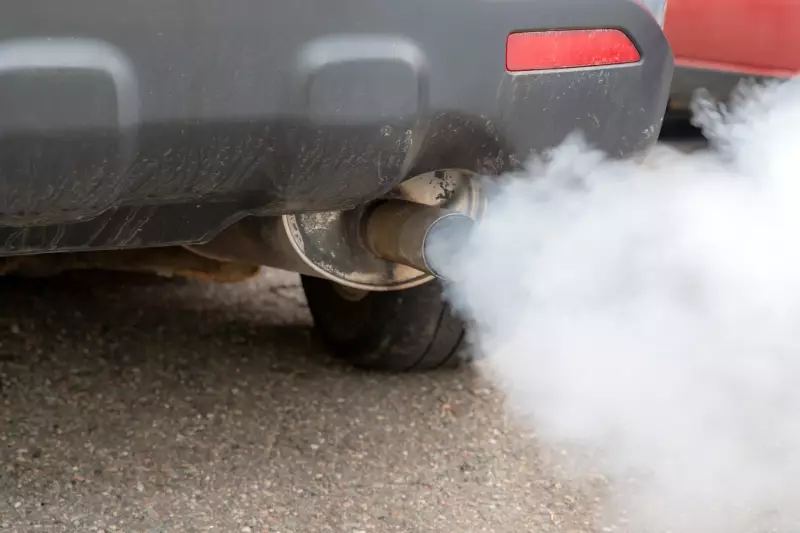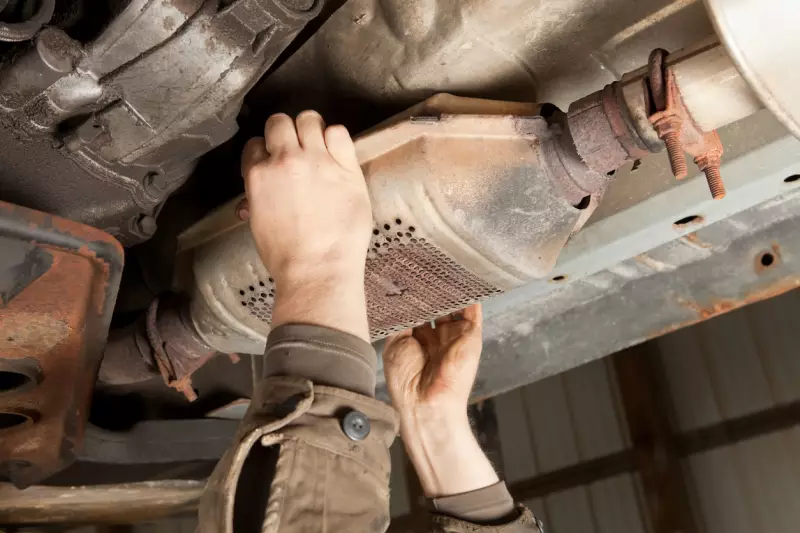Environmentalism and the automobile industry have been connected ever since people figured out that breathing toxic fumes is bad for you. The catalytic converter is one of modern vehicles' many safety and ecological upgrades.
This part of your car is heavily targeted by car thieves looking to make a pretty penny at your expense. Besides the financial burden of replacing a catalytic converter, vehicle owners face legal risks when driving without one.
However, you can gain peace of mind with a few habits and hardware that help protect this pivotal part from local criminals.
What Is a Catalytic Converter?
The catalytic converter is a vital part of a vehicle's emissions system. It takes the byproducts of burning gasoline, such as carbon monoxide, and transforms them into less harmful substances for humans and the environment.
Precious metals like platinum, rhodium, and palladium coat honeycomb-shaped filters within the catalytic converter. These metals trigger the chemical reactions required to neutralize the emissions.
It's located on the undercarriage of most vehicles between the exhaust manifold and the muffler. This positioning may sound like a catalytic converter would be hard to steal, but most aren't welded or strongly secured.
Who Invented Catalytic Converters?
The oldest example of catalytic converters comes from oil engineer Eugene Houdry. He wanted a method to reduce smokestack emissions and eventually applied his research to cover warehouse equipment.
However, Houdry's original solution only worked for vehicles running on unleaded gasoline, the era's primary fuel type for commercial cars. This limitation was due to the lead sticking to the surface of his filtration system and severely damaging future efficacy.
The honeycomb design solved this problem by significantly increasing the catalyst's surface area. Improvements like the three-way converter address additional byproducts like nitrogen oxides and allow modern vehicles to break down up to 98 percent of these dangerous gases.
The Clean Air Act of 1970
Before the Air Pollution Control Act of 1955, the US government had taken a more hands-off approach to air pollution. This legislation directed funds toward air pollution research, ultimately leading to the government's more prominent role in environmental control.
The Clean Air Act of 1970 gave federal and state governments the power to limit emissions from industrial and automotive sources. It also required all vehicles made after 1975 to decrease emissions by 1975. The five-year expedited time frame all but required every vehicle to come with a catalytic converter.
What Does a Catalytic Converter Do?

A catalytic converter reduces the environmental impact of vehicle emissions. It can take 98 percent of detrimental gases and chemically transform them into safer elements.
Here's a list of the harmful toxins most vehicles produce and how the catalytic converter neutralizes them.
- Carbon monoxide is converted into carbon dioxide
- Hydrocarbons turn into water vapor and carbon dioxide
- Nitrogen oxides separate into nitrogen and oxygen
There may be other processes depending on the type of catalytic converter, but these are the processes shared by all types. If vehicles released every dangerous gas they produce, it would significantly impact the environment and increase the risk to surrounding life.
Catalytic converters have five distinct parts that allow them to manage excessive heat, transform fumes, and self-diagnose the part's condition.
Stainless Steel Body
This extremely durable material protects the converter and doesn't break down over time. Ridges are folded into the metal, allowing the converter's shape to remain stable despite severe changes in hot or cold temperatures.
Ceramic Monolith Catalyst
The ceramic monolith catalyst is where most of the magic happens. It is composed of many channels opened over a large surface area.
The walls separating each channel are coated with a catalytic metal such as rhodium or platinum, which reacts to harmful gases upon contact. Each manufacturer utilizes a proprietary combination of metals depending on the vehicle type.
Cushioning Mat
A cushioning mat stabilizes the catalyst and creates a tighter seal between the substrate and the stainless-steel body in case of disfiguration over time. It ensures that all the toxic gases pass through the right area and aren't prematurely released from the system.
Heat Shields
The chemical reactions happening in the converter can release energy (heat) and raise temperatures to 700 degrees Fahrenheit. While the stainless-steel body protects the converter, it doesn't keep the surrounding vehicle parts safe. Heat shields prevent the converter from melting your carpets and setting alight surrounding flammables.
Oxygen Sensor
The O2 sensor checks the oxygen in exhaust gases before and after passing through the catalytic converter. The reading informs the powertrain control module (PCM) on how to maintain fuel economy best. A failing oxygen sensor may lead to engine misfires, bad smells when driving, and increased fuel costs.
Types of Catalytic Converters
Depending on whether the vehicle runs on unleaded gasoline or diesel, there are different types of catalytic converters. These fuel types produce exhaust fumes with varying levels of soot and oxygen, requiring different substrates and conversion methods.
Two-Way Catalytic Converter
The two-way catalytic converter was used in North American automobiles until the early 1980s. As the name implies, these parts only reduced two types of exhaust fumes and did little to manage nitrogen oxides.
Three-Way Catalytic Converter
The three-way converter solved the previous version's problems by splitting nitrogen oxides into separate nitrogen and oxygen compounds. These have become the international standard in gasoline-powered cars.
Vehicles using alternative fuels like ethanol or liquefied petroleum gas previously required owners to tweak their catalytic converters with carburetors. However, introducing oxygen sensors and computerized systems allows for automatic adjustments.
One of these adjustments is their ability to store excess oxygen when the fuel is more aerated. Storing oxygen ahead of time lets the converter operate normally even when there isn't enough oxygen in the exhaust gas stream at the time.
Diesel Oxidation Catalyst (DOC)
This type of catalytic converter is used in diesel engines with special consideration toward cutting down the heavier smells and soot buildup that come with using diesel.
Diesel produces higher amounts of soot than unleaded gasoline, which gets trapped in the catalyst substrate walls. DOCs regularly combust the trapped particulates to prevent excessive exhaust back pressure.
DOCs perform two conversions in their substrate walls. They turn carbon monoxide into carbon dioxide and hydrocarbons into water and carbon dioxide.
Unlike three-way catalytic converters, diesel converters don't actively reduce nitrogen oxides because the high level of oxygen in diesel already affects those emissions.
Why Do People Steal Catalytic Converters?

Catalytic converters have to protect themselves against more than heat and deteriorating substrate. These parts are frequent victims of theft due to the presence of precious, expensive metals like platinum.
Criminals turn the catalytic converter into scrap and cash out on the metals. Depending on the type, market, and condition of the metals, returns on the scrap can range from $150 to $1500.
To deter this new trend, many states have upgraded catalytic converter theft to a felony rather than a class A misdemeanor. Lawmakers are addressing the issue from both sides and have started tightening down on anyone selling aftermarket parts as well.
It also doesn't help that catalytic converters aren't complicated to remove. Although they're located in the less accessible undercarriage of a vehicle, they're typically held in place by only a few bolts. Criminals can remove the converter in a few minutes without attracting too much attention with loud power tools.
Is it Legal to Drive Without a Catalytic Converter?
Technically, you can drive just fine without a catalytic converter. You may get a weird smell in your car, but there shouldn't be performance issues unless the O2 sensor also breaks.
That said, most states have long enacted clean air legislation that requires a working catalytic converter on all vehicles. Law enforcement won't be able to tell you're missing yours on a busy highway, but you'll fail your next car inspection when taking your vehicle for a routine checkup.
How to Prevent Catalytic Converter Theft
Considering replacing a catalytic converter can cost up to $2500, vehicle owners should take proactive measures to protect their assets. The best way to improve safety is to make the part more challenging to remove or make your vehicle a less appealing target.
Choose Smart Parking Spaces
People don't want to commit crimes when they're being watched. If your car is in an area with high foot traffic or good lighting, it's far more likely that someone will witness the crime. Picking a parking space near a door, entrance, or elevator will deter criminals from stealing your catalytic converter.
You could also willingly park your car in a narrower space. This may make backing out more challenging, but it also limits a thief's access to your undercarriage.
Etch or Mark Your Catalytic Converter
Engraving your car parts clearly can deter someone from stealing them. The police will have an easier time recognizing the stolen part, and more shops will be unwilling to buy it. This makes the risk and reward less appealing to the criminal and pushes them to buy another vehicle.
Catalytic Converter Anti-Theft Device
Licensed mechanics can install a guard plate or cage onto your catalytic converter, making it much harder to remove. Rather than undoing a few bolts, criminals would need to disconnect a welded component.
Hardware is also larger than the catalytic converter, making it harder to handle when in the confined space beneath the vehicle.
Other less intensive options include motion sensors, clamps, and alarms. These create visual and audible cues that warn criminals that stealing your catalytic converter is a much higher risk than the car next to yours.
Conclusion
The introduction of the catalytic converter marked a turning point in the relationship between the automotive industry and environmental protection. It massively reduces vehicle emissions and preserves air quality for all living beings.
Unfortunately, deconstructing these harmful emissions involves using valuable materials whose inclusion makes catalytic converters a prime target for thieves. The burden of protecting vehicles falls on the owners and legislation.
Governments have actively fought this trend by worsening punishments for catalytic converter theft. Various aftermarket products can add much-needed protection to your undercarriage. Pair these tools with good parking habits and vigilance, and your vehicle should stay safe against this new wave of crime.








![Best Sites to Check a Car’s History [2025 Review]](https://media.infopay.net/thumbnails/K8lMeG2QLjE46LPqZlmoi6SunKKdT5qvlaRZk6e1.webp)










![Best Sites to Check a Car’s History [2025 Review]](https://media.infopay.net/thumbnails/K8lMeG2QLjE46LPqZlmoi6SunKKdT5qvlaRZk6e1-w356.webp)
